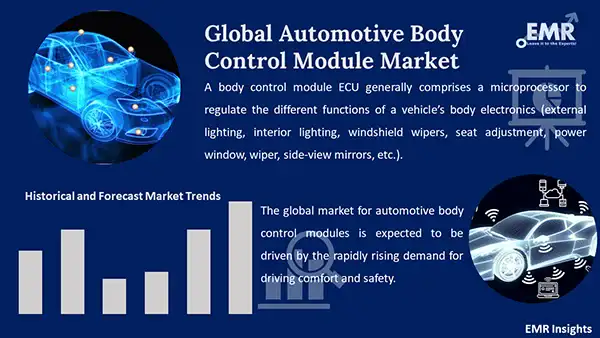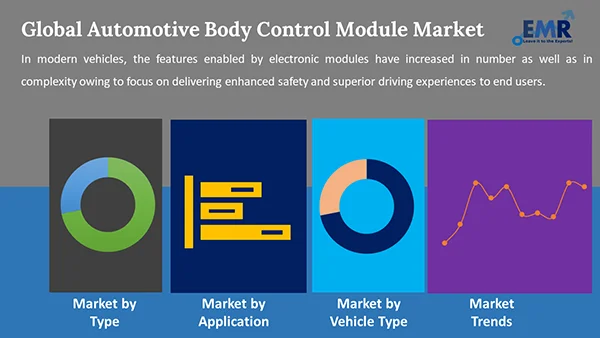
Consumer Insights
Uncover trends and behaviors shaping consumer choices today
Procurement Insights
Optimize your sourcing strategy with key market data
Industry Stats
Stay ahead with the latest trends and market analysis.
The global automotive body control module market is expected to grow at a CAGR of 3.90% during the period 2026-2035.
Base Year
Historical Period
Forecast Period
Compound Annual Growth Rate
3.9%
2026-2035
*this image is indicative*
Read more about this report - REQUEST FREE SAMPLE COPY IN PDF
The global market for automotive body control modules is expected to be driven by the rapidly rising demand for driving comfort and safety. Further, rise in demand for compact solutions featuring technically advanced functions is likely to boost market growth. North America, Europe and Asia are expected to be key markets.

In modern vehicles, the features enabled by electronic modules have increased in number as well as in complexity owing to focus on delivering enhanced safety and superior driving experiences to end users. Thus, automobiles today come equipped with several features including anti-lock braking system (ABS), power-controlled steering, power windows, turn indicators, Android Infotainment System, etc., which are regulated and managed by independently functioning electronic control units (ECUs). The inter-ECU communication in a vehicle is made possible by a body control module (BCM) unit. A body control module uses the vehicle’s bus system [Controller Area Network (CAN), Local Interconnect Network (LIN), etc.] to communicate with different ECUs in the vehicle.
A body control module ECU generally comprises a microprocessor to regulate the different functions of a vehicle’s body electronics (external lighting, interior lighting, windshield wipers, seat adjustment, power window, wiper, side-view mirrors, etc.). Further, ports on the body control module platform enable communication with the various ECUs, instrument clusters, sensors, actuators, etc. Other components may also be connected with the body control module unit according to particular requirements.
Microcontrollers and connectors integrated into a body control module comprise the central structural unit of the system established for control. Operating data are sent to the control module through input devices (sensors, vehicle performance indicators, and variable reactors). After data are processed by the module, a response signal is produced through integrated output devices (including relays and solenoids); through this system of output devices, the body control module carries out coordination between the functions of different electronic systems. Body control modules also provide the diagnostic interface during servicing or repairing of a vehicle. Within a well-equipped mid-range car, the body control module interacts with nearly 60 separate ECUs. As a component of an integrated energy management system, the body control module helps reduce the vehicle’s overall energy consumption.
Embedded software is increasingly being employed in the automotive sector. The small size of these software has been a key factor behind increasing demand for complex embedded automotive solutions. Today, embedded software is used in the development of centralized and distributed body control module architectures. Centralized architectures warrant fewer, highly functional modules as against distributed architectures that are made with a smaller number of modules and a greater number of communication interfaces.

Read more about this report - REQUEST FREE SAMPLE COPY IN PDF
The EMR’s report titled “Automotive Body Control Module Market Report and Forecast 2026-2035" offers a detailed analysis of the market based on the following segments:
By type, the market is segmented into:
By vehicle type, the market is divided into:
By application, the market is classified into:
By region, the market is segmented into:
The report presents a detailed analysis of the following key players in the market, looking into their capacity, and latest developments like capacity expansions, plant turnarounds, and mergers and acquisitions:
The EMR report gives an in-depth insight into the industry by providing a SWOT analysis as well as an analysis of Porter’s Five Forces model.




*While we strive to always give you current and accurate information, the numbers depicted on the website are indicative and may differ from the actual numbers in the main report. At Expert Market Research, we aim to bring you the latest insights and trends in the market. Using our analyses and forecasts, stakeholders can understand the market dynamics, navigate challenges, and capitalize on opportunities to make data-driven strategic decisions.*
Get in touch with us for a customized solution tailored to your unique requirements and save upto 35%!
The market is estimated to grow at a CAGR of 3.90% between 2026 and 2035.
The major drivers of the market include the thriving automotive industry owing to the rising demand for passenger vehicles, stringent government regulations by the government to bolster the safety and increasing complexity in the modern automobiles.
The technological advancements in the automotive industry, coupled with the increasing sales of the electric vehicles, are expected to be the key trends guiding the growth of the industry.
The major regions in the industry are North America, Latin America, the Middle East and Africa, Europe, and the Asia Pacific.
CAN and LIN are the major types included in the market report.
Passenger car, commercial vehicle, and electric vehicle are the significant vehicle types included in the market report.
Interior and exterior are the different applications of automotive body control module.
The major players in the industry are Robert Bosch GmbH, Texas Instruments Incorporated, Continental AG, Infineon Technologies Ag, and HELLA GmbH & Co. KGaA, among others.
Explore our key highlights of the report and gain a concise overview of key findings, trends, and actionable insights that will empower your strategic decisions.
| REPORT FEATURES | DETAILS |
| Base Year | 2025 |
| Historical Period | 2019-2025 |
| Forecast Period | 2026-2035 |
| Scope of the Report |
Historical and Forecast Trends, Industry Drivers and Constraints, Historical and Forecast Market Analysis by Segment:
|
| Breakup by Type |
|
| Breakup by Vehicle Type |
|
| Breakup by Application |
|
| Breakup by Region |
|
| Market Dynamics |
|
| Competitive Landscape |
|
| Companies Covered |
|
| Report Price and Purchase Option | Explore our purchase options that are best suited to your resources and industry needs. |
| Delivery Format | Delivered as an attached PDF and Excel through email, with an option of receiving an editable PPT, according to the purchase option. |
Single User License
One User
USD 3,999
USD 3,599
tax inclusive*
Datasheet
One User
USD 2,499
USD 2,249
tax inclusive*
Five User License
Five User
USD 4,999
USD 4,249
tax inclusive*
Corporate License
Unlimited Users
USD 5,999
USD 5,099
tax inclusive*
*Please note that the prices mentioned below are starting prices for each bundle type. Kindly contact our team for further details.*
Flash Bundle
Small Business Bundle
Growth Bundle
Enterprise Bundle
*Please note that the prices mentioned below are starting prices for each bundle type. Kindly contact our team for further details.*
Flash Bundle
Number of Reports: 3
20%
tax inclusive*
Small Business Bundle
Number of Reports: 5
25%
tax inclusive*
Growth Bundle
Number of Reports: 8
30%
tax inclusive*
Enterprise Bundle
Number of Reports: 10
35%
tax inclusive*
How To Order

Select License Type
Choose the right license for your needs and access rights.

Click on ‘Buy Now’
Add the report to your cart with one click and proceed to register.

Select Mode of Payment
Choose a payment option for a secure checkout. You will be redirected accordingly.
Gain insights to stay ahead and seize opportunities.

Get insights & trends for a competitive edge.

Track prices with detailed trend reports.

Analyse trade data for supply chain insights.

Leverage cost reports for smart savings

Enhance supply chain with partnerships.

Connect For More Information
Our expert team of analysts will offer full support and resolve any queries regarding the report, before and after the purchase.
Our expert team of analysts will offer full support and resolve any queries regarding the report, before and after the purchase.
We employ meticulous research methods, blending advanced analytics and expert insights to deliver accurate, actionable industry intelligence, staying ahead of competitors.
Our skilled analysts offer unparalleled competitive advantage with detailed insights on current and emerging markets, ensuring your strategic edge.
We offer an in-depth yet simplified presentation of industry insights and analysis to meet your specific requirements effectively.
Share